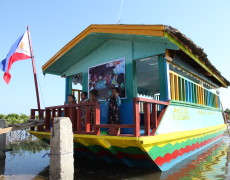Launching and Blessing of Floating Classroom in Zamboanga

For the Bajau families of Zamboanga who traditionally settle along coastal communities, home is where the sea is nearest. As many of them have been displaced by the Zamboanga Siege of 2013 and remain in transitory shelters, boats represent their people’s safe space–making for ideal learning areas for their children.
The boat classroom for the Bajau young learners of Masepla Transitory Site in Mampang, Zamboanga was launched on March 3, 2016. Apart from Cartwheel team members, in attendance during its festive blessing ceremonies were representatives from various stakeholders who have been in collaboration with each other for Angiskul ma Bangka or AmB (“Classes in Bancas”) Early Childhood Education Program: Bajau community members and elders, young learners, local implementing partner Ateneo de Zamboanga University-Center for Community Extension Services (ADZU-CCES), funding partner Karapatan sa Malikhaing Paraan (KaSaMa) and the Spanish Agency for International Development Cooperation (AECID), Barangay Mampang local government, Zamboanga Department of Education-Indigenous Peoples Education Office (DepEd-IPsEO) and the City Social Welfare and Development Office (CSWDO).

Various people and groups coming together to celebrate the cause of culturally relevant education for Bajau children
The opening prayer was led by Bajau elder Abdulla Wahab while the blessing of thanks was shared by Imam Baks Jainal. Messages for the community were given by the Barangay Chairman Leonard Aliangan, Cartwheel Executive Director Pia Ortiz-Luis, ADZU President Fr. Karel San Juan, S.J., KaSaMa representative Dr. Jenny Lind Elmaco, and ADZU-CCES Executive Director Loreta Sta. Teresa.

Fr. Karel San Juan, S.J. (standing, left) of Ateneo de Zamboanga University and Pia Ortiz-Luis (standing in white, right) of Cartwheel Foundation share their messages with the Bajau learners and community members during the launch
Subtiya Utohsaya, vice president of the local community organization Kahapan, Kasulutan, Kasanyangan, Parimpunan or KKKP (Service, Peace, and Progress Organization), delivered a heartfelt response on behalf of other Bajau as the boat classroom was presented. She expressed much joy and gratitude that her people no longer have to roam the streets, begging for alms to survive; she believes that they are journeying on towards change for the good as they embrace the opportunity for education.

Subtiya Utohsaya (rightmost) responds on behalf of the Bajau community members and expresses her gratitude for the mobile learning center
Some Bajau participants, including the teachers, shared their tribe’s cultural treasures through dance and music.

Bajau teacher and mothers dance the traditional Igal-igal (left) and play on the kulintang (right) for the participants’ cultural performance
Inside the boat classroom are indigenous instructional materials prepared by teachers Relinda Montimor, Sariba Abdulbasit, and Maya Oroc with the help of the parents, using resources from around their community. AmB learners have been using the boat school for their classes since March 7. Though it is presently docked in an area near the mangroves of their transitory site, the boat classroom is intended to move together with the children once they eventually relocate to their families’ more permanent coastal homes.


